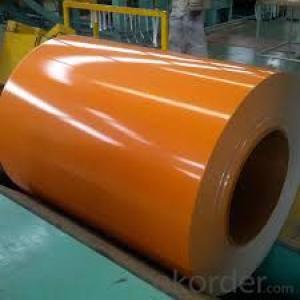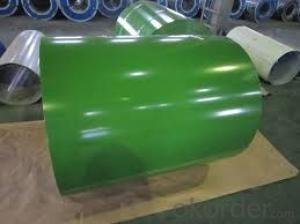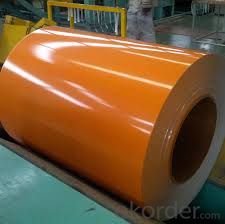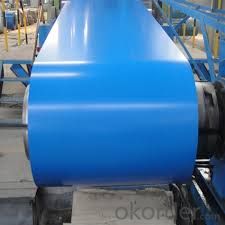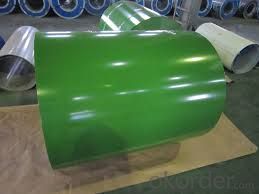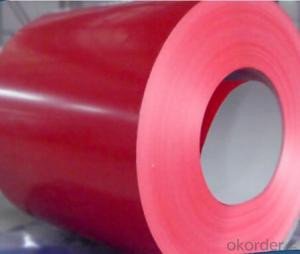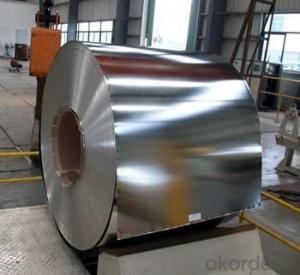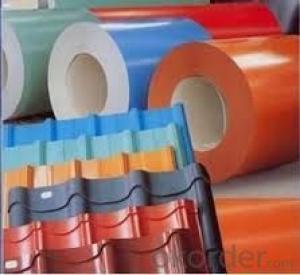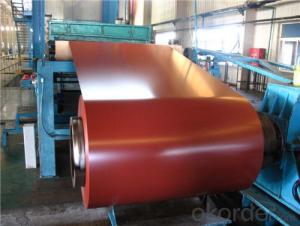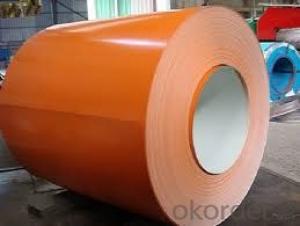Ral Color Prepainted Galvanied Steel Coil/Prepainted Steel Rolled
- Loading Port:
- Shanghai
- Payment Terms:
- TT OR LC
- Min Order Qty:
- 20 m.t.
- Supply Capability:
- 9000 m.t./month
OKorder Service Pledge
OKorder Financial Service
You Might Also Like
Product Description
Prepainted galvanized steel coil, PPGI, PPGL, Prepainted galvalume/aluzincsteel, Color Coated Galvalume Steel Coil, Prepainted Galvalume Steel Coils, RAL color, 0.15-1.5mm, SGCC, CGCC, CGLC, DX51D, TDC51D, ASTM A653, CS TYPE, S280GO, S350GD, G550, JIS G3312, EN 10169 JIS G3322, ASTM A755/755M, comercial and structual quality
Specifications of Pre Painted Galvanized Steel Coil:
1) Capacity: More than 20, 000 tons per month for PPGI coil product manufacture
2) Standard: JIS G3302, JIS G3312, ASTM A653M/A924M 1998
3) Grade: SGCC CGCC, DX51D, TDC51D, ASTM A653 CS TYPE, S280GD, S350GD, G550
4) Thickness: 0.15mm-1.5mm
5) Zinc coating weight: Z60-275G/M2, G30-G90
Zinc coating: Z60, Z80, Z100, Z120, Z180, Z275, G30, G60, G90
Alu-zinc coating: AZ60, AZ80, AZ100, AZ120, AZ180, G30, G60, G90
6) Width: 600mm-1250mm, 914mm, 1000mm, 1200mm, 1219mm, 1220mm, 1250mm or according to the customer's request
7) Coil ID: 508mm-610mm
8) Coil Weight: 3-6mt, or according to the customer's request
9) Color: RAL, or customer sample color
RAL9016, RAL9002, RAL5015, RAL5002, RAL3000, RAL3020, RAL3009, RAL6005, RAL8017 etc.
10) Color coating type: PE, PVDF, SMP, HDP, etc.
Regular Polyester, Silicon Modified Polyester, Polyvinylidene Floride, PVDF, Super Low Gloss Polyester
11) Surface protection: PVC film protected according to customer requested
12) Min trial order: 25 tons for 1X20' per delivery
PPGI Manufacture
ThicknessWidth LengthColor Coating type
0.2mm-1.5mm600mm-1250mmAs your requestRALPE, PVDF, SMP, HDP, etc.
Coating Chief Feature
ItemThicknessTypeFeature
Laminated film50μ MPolyethyleneProtecting from scratchs and contamination
(option)
Top coat20μ MPolyester FluorineChemical resistance and formability
Primer coat5μ MPolyesterWorkability, corrosion resistance and adhesion to the primer coating
Chemical treatment1μ MChromateGood adhesion and corrosion resistance
Substrate0.2mm-1.2mmGI. GL, ALGI. GL, AL
Back coat5± 2μ MEpoxyCorrosion resistance and adhesion to the substrate
Characteristics:
20 years outdoor liability approved, Corrosion protection, Long life-time for coated color
APPLICATION:
Exterior decoration of buildings: Roof and wallboards of industrial, commercial, residential and public facilities
Interior decoration of buildings: Wallboards, ceiling boards, partition boards, fireproof doors
Building accessories: Window panels, signboards
Home appliances: Oil/gas boilers, rice buckets, portable gas burners, etc.
World wide customer satisfaction:
More than 50 worldwide customers none-risky experiences approved.
Yogic has been exporting steel coils to more than 50 countries directly. Our long term supply extends to USA, UK, Germany, Italy, Spain, Belgium, France, Poland, Greece, Ukraine, Belarus, Russia, Turkey, Egypt, Saudi Arabia, Iran, Ethiopia, Niger, Brazil, Colombia, Chile, Peru, Australia, New Zealand, etc...
| Classified symbol | Yield Point Minimum N/mm2 | Tensile Strength Minimum | Elongation Minimum % | Application | ||||
| N/mm2 | Nominal Thickness mm (t) | |||||||
| JIS | CNBM | 0.25≤t<0.4 | 0.4≤t<0.6 | 0.6≤t<1.0 | 1.0≤t<1.6 | |||
| G3312 | specification | |||||||
| CGCC | CGCC | -205 | -270 | -20 | -21 | -24 | -24 | Commercial |
| CGCD | CGCD | --- | 270 | --- | 27 | 31 | 32 | Drawing |
| --- | CG340 | 245 | 340 | 20 | 20 | 20 | 20 | Structural |
| CGC400 | CG400 | 295 | 400 | 16 | 17 | 18 | 18 | Structural |
| CGC440 | CG440 | 335 | 440 | 14 | 15 | 16 | 18 | Structural |
| CGC490 | CG490 | 365 | 490 | 12 | 13 | 14 | 16 | Structural |
| CGC570 | CG570 | 560 | 570 | --- | --- | --- | --- | Structural |
| ASTM Designation | Yield Point Minimum | Tensile Strength Minimum | Elongation Minimum % | Application | Q/BQB 445-2004(China standard) | ASM A653/A653M | JISG 3312 | |
| ksi(MPa) | ksi(MPa) | TDC51D+Z | (CS TYPE A+Z) | CGCC | ||||
| A653(M)-99 CS TYPE A,B,C | --- | --- | --- | Commercial | TDC52D+Z | CGCD | ||
| A653(M)-99 FS | --- | --- | --- | Lock Forming | TS250GD+Z | (G250+Z) | - | |
| A653(M)-99 DS | --- | --- | --- | Drawing | TS300GS+Z | (G300+Z) | CGC 400 | |
| A653(M)-99 SS Grade33(230) | 33(230) | 45(310) | 20 | Structural | TS350GD+Z | (G350+Z) | CGC490 | |
| A653(M)-99 SS Grade37(255) | 37(255) | 52(360) | 18 | Structural | TS550GD+Z | (G550+Z) | CGC570 | |
| A653(M)-99 SS Grade40(275) | 40(275) | 55(380) | 16 | Structural | ||||
| A653(M)-99 SS Grade50(345) | 50(345) | 65(450) | 12 | Structural | ||||
| A653(M)-99 SS Grade80(550) | 80(550) | 82(570) | --- | Structural | ||||
FAQ
1. Is the sample available?
Yes, samples can be sent for test if you need.
- Q: Do any tour players use steel shafted woods? And are there any real advantages to having steel shafted woods? I have only played with one person to use steel shafted woods, he tells me thats because he cant hit it straight with graphite, however he is a very short hitter.
- I'd be very surprised if there are any tour players still using steel shafts on their woods (I did actually see Tiger with a steel shaft on a driver during a clinic in 2002). Top end graphite shafts have gotten so much better there's just no reason for pros not to use them anymore. That being said, I use a 45 True Temper stiff steel shaft in my driver (Cobra X-speed, 9.5*). Graphite is longer than steel, but the distance I've lost is minimal (maybe 10 yards and I still put it out there 250+ consistently). The extra weight has actually helped me stay in control which has improved my overall driving considerably, and the very low torque in a steel shaft has paid off huge in accuracy. You're paying minimum $60 (or more) for a graphite shaft with a similar torque rating to any steel shaft. I hit easily twice as many fairways since the switch. I've even switched out my other fairway woods too, the feel and control are so much nicer. I've considered going with a 46 on the driver to try to regain some of the distance, and at $7 per shaft I can actually just go do that whenever I want. Don't get me wrong, if I were playing for money or flirting with par I'd invest in good quality graphite stuff no question, but it doesn't make sense to me right now. I'd recommend to anyone looking for more consistency out of their woods to take $20 to your golf shop and try it out. It's a lot cheaper than the alternatives.
- Q: Are steel coils used in furniture manufacturing?
- Yes, steel coils are commonly used in furniture manufacturing. They are often used as a supportive framework in upholstered furniture, such as sofas and chairs, providing stability and durability to the overall structure.
- Q: I want to save water $$, so I want to use frozen steel to cool my coke. possible or no?
- Hey man, don't you think it would save more $$$ to cool your coke in the fridge than trying to cool steel? How do you plan on cooling the steel? And you can't freeze steel but you can make it cold. You are just joking right, I hope so anyway?
- Q: How much do steel coils weigh?
- The weight of steel coils can vary depending on several factors such as the thickness, width, and length of the coil, as well as the specific type of steel being used. Generally, steel coils can weigh anywhere from a few hundred pounds to several tons. It is important to note that steel coils are typically measured in terms of their weight per unit area, known as the coil's "basis weight" or "coil weight".
- Q: How are steel coils processed for cutting to length or blanking?
- Steel coils are typically processed for cutting to length or blanking through a series of steps. First, the coils are unwound using a machine called an uncoiler, which feeds the steel into the cutting process. Then, the steel passes through a leveler to ensure a flat surface. Next, it enters a shear or blanking process, where the steel is cut into desired lengths or shapes. Finally, the cut pieces are stacked or packaged for further use or distribution.
- Q: What are the different methods of corrosion protection for steel coils?
- There are several methods of corrosion protection for steel coils, including but not limited to: 1. Coating: Applying a protective layer such as paint, polymer, or zinc coating on the surface of the steel coil to prevent direct contact with corrosive agents. 2. Galvanizing: Immersing the steel coil in a bath of molten zinc, creating a protective coating that prevents corrosion. 3. VCI (Vapor Corrosion Inhibitor): Using volatile corrosion inhibitors that release molecules to form a protective layer on the steel coil, preventing corrosion. 4. Oil or Wax Coating: Applying a layer of oil or wax on the surface of the steel coil to act as a barrier against moisture and corrosive elements. 5. Cathodic Protection: Using sacrificial anodes or impressed current to protect the steel coil by providing a more easily corroded metal that attracts corrosion instead. 6. Desiccants: Placing desiccant materials such as silica gel or molecular sieves inside the packaging to absorb moisture and prevent corrosion. 7. Environmental Control: Maintaining controlled humidity levels, temperature, and proper ventilation in storage areas to minimize the risk of corrosion. 8. Proper Handling and Storage: Implementing safe handling practices during transportation and storing steel coils in dry, covered areas away from corrosive substances. It is important to select the appropriate method based on the specific application, environment, and desired level of protection for the steel coils.
- Q: I'm not sure.Alloy stainless steel 308 series.
- No. People have been cooking on stainless steel for years.
- Q: How are steel coils used in the production of doors and windows?
- Steel coils are vital components in the production of doors and windows due to their strength and versatility. These coils are typically made from high-quality steel and are used in various stages of the manufacturing process. Firstly, steel coils are used to create the frame of the doors and windows. The coils are unrolled and cut into specific lengths, depending on the desired dimensions of the frame. The steel is then bent and shaped into the required frame design, ensuring that it is strong and durable. Next, the coils are used to produce the panels or glass holders for the doors and windows. The steel is cut and formed into the desired shape, and then it is either welded or attached to the frame. This ensures that the doors and windows have a sturdy structure and can handle the weight and pressure of the glass or panels. Additionally, steel coils are also used to create the hinges and other hardware components of the doors and windows. The coils are cut and shaped into the necessary parts, ensuring that they are strong enough to support the movement and functionality of the doors and windows. Furthermore, steel coils can be used for decorative purposes. They can be embossed or coated with different finishes to enhance the appearance of the doors and windows. This allows for a wide range of design options, enabling manufacturers to create doors and windows that suit various architectural styles and preferences. In summary, steel coils play a significant role in the production of doors and windows. They are used to create the frame, panels, hinges, and other hardware components, ensuring strength, durability, and functionality. Additionally, they can be used for decorative purposes, allowing for customization and aesthetic appeal.
- Q: How are steel coils used in the production of metal shelving?
- Steel coils are an essential component in the production of metal shelving. These coils, which are made from high-quality steel, undergo a series of manufacturing processes to transform them into sturdy and durable shelves. Firstly, the steel coils are unwound and flattened to the desired thickness using a machine called a slitter. This process ensures that the coils are of uniform size and thickness, which is crucial for producing consistent and reliable shelves. Next, the flattened steel is cut into specific lengths using a shear. These cut-to-size pieces are then sent to a press brake, where they are bent and shaped into the desired shelf design. The press brake applies pressure to the metal, allowing it to be folded or formed into different angles and shapes, such as shelves with raised edges or adjustable brackets. Once the shelves have been formed, they go through a process called welding, where any joints or seams are securely fused together. This welding process ensures the structural integrity of the shelves, making them capable of supporting heavy loads and maintaining their shape over time. After welding, the shelves undergo surface treatment to enhance their appearance and protect them from corrosion. This can include processes such as cleaning, sandblasting, and painting. The surface treatment not only improves the aesthetic appeal of the shelves but also extends their lifespan by preventing rust and other forms of deterioration. Finally, the shelves are inspected for quality control to ensure that they meet the necessary standards. This includes checking for any defects, measuring dimensions, and conducting load-bearing tests to ensure the shelves are capable of withstanding the intended weight capacity. In summary, steel coils are used in the production of metal shelving by being unwound, flattened, cut, bent, welded, treated, and inspected. These coils provide the raw material necessary to create strong, durable, and aesthetically pleasing shelves that can be used in various settings such as warehouses, retail stores, and homes.
- Q: Okay basically bought my girlfriend Tiffany sterling silver necklace for her birthday and now christmas is coming up i want to buy her this DG Necklace. BUT i have discovered its steel. And its ?110. I am not a rich man i am infact quite young and we have been together for an incredibly long time! I wanted to know is Steel seen as a cheap necklace, whats your say? Don't give me all this bull about her being grateful as she does not expect this. BUT I WANT IT TO BE NICE. Whats your say? Is Steel good? Does it get dirty? Does it shine? Is it worth it? Thanks x
- Things about steel~ Basically indestructable Should be non magnetic It shines Why not get it
Send your message to us
Ral Color Prepainted Galvanied Steel Coil/Prepainted Steel Rolled
- Loading Port:
- Shanghai
- Payment Terms:
- TT OR LC
- Min Order Qty:
- 20 m.t.
- Supply Capability:
- 9000 m.t./month
OKorder Service Pledge
OKorder Financial Service
Similar products
Hot products
Hot Searches
Related keywords
